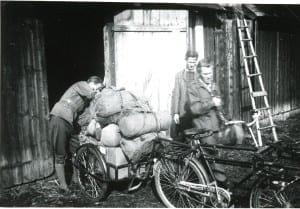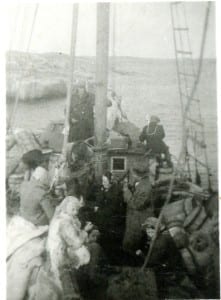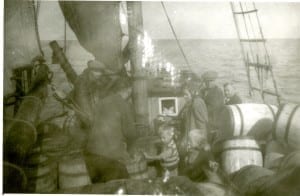My family fled as refugees from Estonia in 1944; they were among the ones who survived the journey
Click here to access BBC Estonia country profile >

Estonia, Summer of 1944: Preparations for leaving the country. My parents and other family members escaped from Estonia to Sweden, in separate boats across the Baltic Sea, in September 1944 during the second Soviet occupation of the Baltic states. A family friend who made a similar journey (in her case, by sea to Germany) has remarked that her experience was like jumping from the second storey of a burning building and making a run for it. Click on photos to enlarge them; click again to enlarge them further.

Boat on which my father and grandfather and other refugees made it across the Baltic Sea in September 1944 during the Second World War. Other family members travelled across the Baltic on a larger vessel.

Boat on which my father and grandfather made it across the Baltic Sea in September 1944. My grandfather is on the right, in the photo.
I was born in Sweden in 1946, after my parents and several other members of the extended family including my grandparents on my mother’s side crossed the Baltic Sea to Sweden in the autumn of 1944.
They made the trip in two separate boats.
There were many close calls in the period of time leading up to September 1944.
My grandmother did most of the organizing, for the journey to the other side. Women could move about relatively freely, at that time, in the circumstances. Men of military age could not move about so freely. My grandmother was a keen organizer, with extensive networking capabilities.
One member of the family, one year old at the time, was given up for dead when he arrived in Sweden. He survived, because my mother decided she would do what she could, and would get the medical information that she needed, to enable him to survive. Thanks to her efforts, and her strong will, he survived.
These many years later, if you have a connection with those times, and if you now find yourself reading this post, let us celebrate the fact that you are, indeed, a survivor as well.
And that is what it was. It was the journey to freedom.
Updates
A Sept. 21, 2015 Globe and Mail article focusing on documentary photography by Sebastiao Salgado is entitled: “Humanity’s spirit and cruelty, in focus.”
From a Facebook post I have learned that the Castel Bianco was among the ships that brought Estonian refugees from Sweden to Canada; a July 2, 2016 Welland Tribune article reads: “Ships That Ply the Lakes: Castel Bianco.” The ship that I travelled on with my family from Sweden to Canada in 1951 was called the Gripsholm.
An Aug. 25, 2016 Quartz Africa article is entitled: ““Nobody is ever just a refugee”: Chimamanda Ngozi Adichie’s powerful speech on the global migrant crisis.”
A Jan. 8, 2017 Estonian World article is entitled: “The UN classifies Estonia as a Northern European country.”
A March 24, 2017 Estonian World article is entitled: “The victims of Soviet deportations remembered in Estonia.”
First Nations peoples
My sense is that First Nations peoples in Canada have in many cases ended up as refugees and deportees. In this context, an Aug. 20, 2016 CBC article is entitled: “Sayisi Dene found ‘utopia’ with 5-day dogsled escape to Tadoule Lake: Defying the government to flee death, destruction and ‘clutches of evil’ at Dene Village.”
An Aug. 22, 2016 Toronto Star article is entitled: “Sixties Scoop survivors’ day in court finally arrives Tuesday: Indigenous Canadians taken from their homes and their culture suing Ottawa, decades later, over the federal government’s duty to them.”
A march 28, 2017 CBC article (referring to a short documentary) is entitled: “Peace River Rising: Is there a connection between violence against Indigenous women and violence against the land?”

Seems that the photos are taken on board the ship “Karin”. Any passenger list availale?